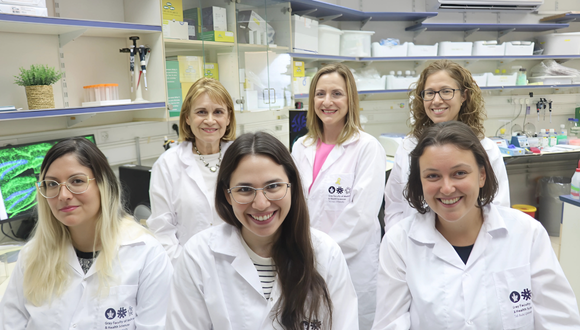A New Mouse Model May Help Develop Treatments for an Ultra-Rare Genetic Disorder Affecting Just 40 People Worldwide
A major step forward in the search for a cure for GRIN2D-related disease
Researchers from the Gray Faculty of Medical and Health Sciences at Tel Aviv University have developed a knock-in mouse model carrying the orthologous p.Val667Ile mutation in Grin2d, mimicking the human condition caused by GRIN2D mutations. This model replicates the ultra-rare GRIN2D-related developmental and epileptic encephalopathy (DEE), allowing scientists to study disease mechanisms and assess pharmacological and gene-based therapeutic strategies.
The study was led by Prof. Moran Rubinstein and Prof. Karen Avraham, Dean of the Gray Faculty, in collaboration with graduate students Mor Yam, Julan Nasir, Daniel Gelber, Shir Cohen, Roni Gal, Mor Ovadia, Mor Bordenik-Cohen, and Eden Peled from TAU’s Gray Faculty and Sagol School of Neuroscience. Additional contributors included Dr. Moran Heuiman-Kedem and Prof. Aviva Fattal-Valevski from the Pediatric Neurology Institute at Dana-Dwek Children’s Hospital, Tel Aviv Medical Center, and Prof. Christopher McKeown and Prof. Wayne Frankel from Columbia University in the U.S.
Prof. Avraham explains:
“We were contacted by the parents of Adam, an 8-year-old Israeli boy who is one of just around 40 people worldwide diagnosed with this devastating genetic disorder. The GRIN2D mutation leads to DEE, characterized by seizures, severe motor and cognitive delays, and often premature death.”
Adam’s mother, Eden Maimon Benet, adds:
“At Tel Aviv University, we met an exceptional, all-female research team who took on the mission of finding a treatment for our son. Knowing Adam personally only deepened their dedication. We started this journey when he was two, and today we finally see real hope.”
Initially, the team aimed to characterize the disease by introducing the patient-specific GRIN2D mutation into mice. The first-generation model was nonviable, with pups dying within weeks—highlighting the severity of the mutation. To continue their work, the team engineered a viable line of heterozygous mice carrying the mutation without showing symptoms, enabling breeding and experimental analysis.
The symptomatic mice showed strong parallels with human DEE patients. Most died within the first few weeks of life, with only a few surviving up to three months. The team assessed their development at four stages: two weeks (infancy), three weeks (analogous to toddlerhood), four weeks (similar to early childhood), and five weeks (onset of puberty).
Prof. Rubinstein notes:
“Due to the rarity of the disease, its progression is not well documented. The model enabled us to identify hallmark features at each stage. Neurological symptoms like seizures, hyperactivity, and motor dysfunction appeared early. Cognitive deficits emerged later and progressively worsened. Most mice died before reaching sexual maturity due to severe seizures.”
Further studies focused on neuronal communication in the cerebellum, a brain region critical for motor coordination. Abnormalities in Purkinje cell activity were detected as early as postnatal day 14, followed by dysregulated neuronal connectivity and structural changes. These findings shed light on the pathophysiological mechanisms underlying the disorder.
Electroencephalography (EEG) revealed persistent interictal abnormalities in mutant mice, matching those seen in patients. Prof. Rubinstein elaborates:
“Unlike most epilepsies where brain activity normalizes between seizures, GRIN2D-DEE shows continuous disruptions. We developed EEG metrics that identified the same disturbances in both mice and humans—strongly validating our model.”
After confirming the model's translational relevance, the team evaluated known and experimental therapies. Ketamine, previously suggested as a treatment, exacerbated seizures at higher doses. In contrast, memantine (10 mg/kg) and phenytoin (30 mg/kg) provided partial rescue of cognitive and electrophysiological measures.
Dr. Heuiman-Kedem comments:
“Mouse models are essential for advancing clinical decisions in rare diseases. They allow us to test safety and efficacy before treating patients. In this case, our model supported memantine’s use and revealed ketamine’s risks. When human studies are limited, preclinical models can drive meaningful clinical insights and personalized treatment approaches.”
Prof. Rubinstein concludes:
“Our GRIN2D-DEE mouse model is a valuable tool for exploring the disease and identifying effective treatments. We are now advancing toward additional drug and gene therapy options. Early results show promise in improving cognition, motor function, and survival. We hope this work brings real progress and hope to families facing this devastating condition—and to others affected by related neurodevelopmental disorders.”





